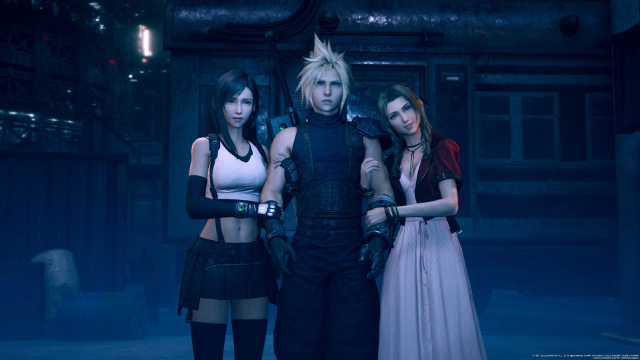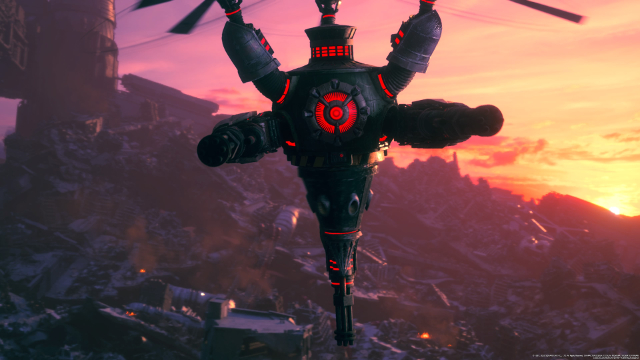It’s been over 23 years since Final Fantasy 7 released, seizing the moment that video game characters transitioned from 16-bit sprites to (blocky) 3D-animated models, and blowing the minds of gamers worldwide with a one-of-a-kind story about a ragtag group of eco-warriors taking on a ruthless megacorporation.
It was heavy stuff back then, but it set the bar for the types of stories that games could tell, and thus it went largely unmatched in the years following its release.
Final Fantasy 7 Remake takes cues from some of the best games to release in the past two decades, all while maintaining the best parts of the original’s weirdness.
I was at first skeptical that Remake could balance these elements without losing anything that made the original great. However, after 50 hours spent adventuring as spiky-haired protagonist Cloud Strife, I’m comfortable calling Final Fantasy 7 Remake the best Final Fantasy game I’ve played in decades.
In fact, it could be the best Final Fantasy game I’ve ever played — period.
Final Fantasy 7 Remake Review: Modern Mythology

Welcome to the iconic city of Midgar, a steel-plated metropolis built atop the dreams and aspirations of those less fortunate souls living in the slums and shantytowns below.
While the original Final Fantasy 7 only touches on this place, giving it no more than about five hours of attention, Remake digs deep, majestically reinventing Midgar and reintroducing its inhabitants as regular people who could truly live and thrive together.
Across its 35- to 45-hour campaign, Final Fantasy 7 Remake grabs your hand and throws you down the nearest alleyway, introducing you to an unexpected range of sights, sounds, and storylines, but there are stops along the way that let you breathe and take everything in.
For those unfamiliar, the Midgar of Final Fantasy 7 was a hostile, unfriendly, and hopeless place. While the same is true of Remake‘s Midgar, this version is rendered in gorgeous 3D, containing details that give this setting far more room to stretch than it ever has before.
The denizens of Remake‘s Midgar drink, dance, eat ice cream, and fall in love amidst the scrapyards and hodgepodge buildings lining the lower slums, and it somehow manages to feel like a real place as a result.
Humanity is the most visible element of Final Fantasy 7‘s world, and it grounds this place in such a way that it’s truly hard to let go of when the credits roll. Never before has so much heart, wit, and character shone through each interaction you have in the world of Final Fantasy 7.
Side-quests that might be considered cheap filler in other games now serve to set things up for the broader plot, or at the very least anchor Cloud in the world around you. Many bring the slowest moments to life with humor and/or subtle details that foreshadow later story events or reflect Cloud’s own development as a character. And they often reward you well for completing them, granting you access to brand-new weapons and other powerful items.

Midgar’s urban and industrial sprawl now has a logical sense of place and purpose. No longer simply painting the picture of extreme urban decay, it now tells the richer and deeper story of how the fictional city has developed. Each familiar location makes a return, from Wall Market to the Sector 7 Slums.
These locales instantly trigger nostalgia for me as a 23-year Final Fantasy 7 veteran, and I’m deeply pleased by seeing them come to life in Remake. Even the mysterious Train Graveyard is now much more fleshed out. However, only a couple of brand-new locations are introduced in Remake, which focuses on density as opposed to breadth.
Environments in Remake look phenomenal and succeed in painting Midgar as not just a big city, but a leading character in the story. Unfinished construction projects pile on top of one another as nearby citizens work together to eke out a living. Granted, some textures are low-res or outright missing. The one key example being the door to Cloud’s apartment in Chapters 3 and 4, which just looks like a solid block of color.
Meanwhile, many character animations are noticeably out-of-sync with the non-Japanese voice dubs. Hilarity ensues when a character’s lips outright stop moving while the voice track continues playing, which is more often the case with minor characters in side quests.
However, these are small details when you look out into the horizon (in any direction) and see just how immense everything around you is. The visuals of Final Fantasy 7 Remake surpass just about everything else out there, pulling some truly baffling tricks to give a CGI-quality flair to every scene.
Giving even Half-Life: Alyx a run for its money, Final Fantasy 7 Remake offers some of the best uses of volumetric lighting I’ve ever seen in a game, such as when you first wander into Wall Market and see the contrasting beacons of neon light clashing against one another, or when you step into Shinra HQ and look out over the city below.
Playing on a fancy HDR-enabled television is an unmitigated spectacle, and I wholeheartedly recommend it.

A major difference between Final Fantasy 7 and Remake is tone. While the slums of the original were an oppressed, repressed place, Remake spins this Midgar as a place of hope.
Minor characters like Wedge, Jessie, and Biggs are fleshed out and given tons of heart, making their stories not just relatable side-arcs, but ones central to the heart and soul of the main story itself. That’s not to mention the new characters that have been added are instantly memorable, such as motorbike-flaring speed demon Roche and coin-flipping cowboy Chocobo Sam.
I’m disappointed that none of them were given the spotlight longer, but that just goes to show how much fun these characters are to be around.
Many of the weirder monster designs from the 1997 original not only make a return but have a sense of logical place within the world around you. The common Gorger feeds on metal scrap, while the oddly-shaped Smogger robot is purposefully used for transporting hazardous byproducts from giant ‘mako’ reactors and carpeting the Midgar slums with waste and smog.
Remake incorporates the incredible cinematic storytelling style of titles like God of War (2018) and Devil May Cry 5, which is to say that it keeps the drama onscreen as much as it possibly can. It does all of this while peppering each shot with dramatic camera angles and fantastic delivery of its many clever and heartfelt lines.
While fans of the original are long familiar with the protagonist, Cloud, a genetically-modified swordsman with the iconic Buster Sword at his back, Final Fantasy 7 Remake has taken his character apart and truly analyzed what makes him tick, a treat to watch as you follow his journey and gain insight into his troubled inner world.

Combat feels incredible in Final Fantasy 7 Remake. Granted, turn-based mode hasn’t made a real comeback, but the new action combat is some of the deepest and most addictive in the series.
As you cut, punch, and shoot your way through some of the most hectic and exciting battles and boss battles in a recent Final Fantasy title, the vastly reimagined new ATB (Active Time Battle) system courteously allows you to stop every few seconds to make tactical decisions in a paused combat window. This works amazingly well, imbuing action with a rich, deep, tactical element.
The menu itself is well-organized, giving you options to use Items, Magic, or Abilities. This works even better than the original, which never gave you too much time to hang about in a menu as enemies continued taking their turns while you were busy perusing your options. This is no longer the case, as combat slows down to a halt while you make the best possible choice.
This doesn’t mean that every attack will land, however! There’s a satisfying extra layer of challenge that comes from the possibility that even your strongest attacks, Limit Breaks, can be deflected, dodged, or outright interrupted if not lined up at the right moment.
One complaint about this new combat system is how easy it is to lose control of the camera, especially when fighting in a tight space with lots of objects that the camera needs to pan around. Since most fights tend to happen in corridors and small arenas, the camera will often clip through stuff while you’re trying to focus. It’s frustrating at first, but forgivable given that the camera can be configured in-game.
Materia is back, and it’s better here than it ever was before. For those unfamiliar, the materia system allows you to put colored orbs into slots in your gear, giving you the powers that the ‘materia’ orb is imbued with. Each one still earns experience points and levels up individually, which is great, especially because it lets you quickly switch each character’s loadout on the fly without losing any of your skill progress.
It’s an absolute delight to be able to mix and match these glowing magical orbs to quickly prepare yourself to take on certain boss encounters and battles, and the variety is surprisingly full. If you don’t want to cast any spells, you can still deck your gear out with materia that boosts your stats or makes your ATB gauge fill up faster in combat.
It was already a great system in the original; now, it’s downright addictive.

For the better part of 23 years, Final Fantasy 7 was one of my favorite video game soundtracks of all time. This might have been the one area I was most skeptical about when playing Remake, but it did not disappoint.
The soundtrack of Final Fantasy 7 Remake has such incredible variety in tone and range that I’d be shocked if it didn’t receive a Grammy nomination. The seven or so hours of original music from the likes of Nobuo Uematsu and Masashi Hamauzu illustrate the exact feeling that Remake wants you to have at every moment.
It’s a treat to hear different parts of the arrangement layer on top of one another as you progress through a scene or an encounter, something that Final Fantasy 7 Remake clearly borrowed from NieR: Automata, and which I’m profoundly grateful for.
Remake‘s musical arrangement is, dare I say, perfect, and I left the whole thing playing on repeat as I wrote this review.
Final Fantasy 7 Remake Review — The Bottom Line

Pros
- Faithful recreation of an unforgettable and beloved story
- Midgar is brought to life
- Combat represents the perfect crossroads of new and old
- A full cast of loveable characters
- One of the best soundtracks in a game
- Positively gorgeous visuals
Cons
- Missing or low-fi textures in some areas
- Messy camera before tweaks
- Some poor character animations
Final Fantasy 7 Remake is a far more difficult game to review than I expected. I love almost everything about it, so much so that I struggle to find the words to do it the justice I believe it deserves.
While it still has minor technical issues, they never got in the way of Remake ramming its fingers into my nostrils and dragging me face-first through one of the deepest, most satisfying, and most downright engulfing Japanese RPG campaigns I’ve ever experienced.
[Note: A copy of Final Fantasy 7 Remake was provided by Square-Enix for the purpose of this review.]







Published: Apr 15, 2020 08:28 am